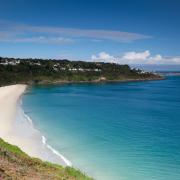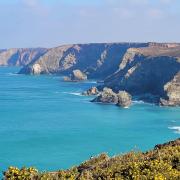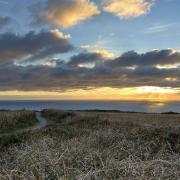A new survey reveals that many of us have been looking to the coast path for help to get through the challenge of lockdown

In the midst of a global health pandemic, equity of access to the great outdoors in order to support our physical and mental wellbeing has come into sharp focus.
Research shows spending time outdoors in nature has huge potential to improve our physical and mental health: reducing stress and anxiety, lowering blood pressure, increasing cardiovascular health and improving mood. There are many health benefits that come from combining walking, with spending time in green spaces and being next to water – three things the South West Coast Path offers. However, as a nation, we’re not walking enough and physical inactivity in the UK could be costing the economy as much as £20 billion a year. But could our environment have the answer?
National landscapes like the South West Coast Path are increasingly recognised as part of the ‘Natural Health Service’. The path is a destination for millions of people looking to stay active, exercise, relax, be mindful, connect with nature – and generally reap the health benefits it offers.
It’s estimated that walking National Trails could save the NHS £167 million in health benefits every year. The South West Coast Path alone could help save the NHS over £40 million a year – that’s £63,000 for every mile of the 630-mile route. Walking coastal paths has also led to fewer premature deaths.
Headland walks particularly provide a chance to exercise body and spirit. Reach the top and pause and look around at the horizon, take a breath and leave some problems behind, even for a moment, with this walk to Lizard Point.

Boots on? Let’s go!
Britain’s most southerly place and a rugged tail of rock with savage reefs, the Lizard is riddled with wrecks and ringed with lifeboat stations. This is the best place to spot a chough, the Cornish national emblem, which was extinct in England until three flew in from southern Ireland at the start of this century, leading to a thriving colony.
Look out for seals below – but tread lightly in the tamarisk grove where more than 200 travellers lie buried beneath your feet. There are numerous paths leading back inland all around the point if you wish to shorten the walk.
1. Parking on the village green at Lizard village, take the road signed to Lizard Head and follow it slightly downhill. Go straight ahead then when the road curves to the left follow the footpath waymarkers downhill until the track stops in front of some houses. Pick up the footpath through the gate straight ahead of you, to the right of these houses. Follow the track towards the coast, to join the South West Coast Path at the Caerthillian National Nature Reserve.

The exposed coastal grassland at Caerthillian provides a unique habitat for a wide variety of wildflowers. Part of the Lizard National Nature Reserve, it is also designated as a Special Area of Conservation and is one of the richest wildflower areas in the UK.
As you walk southwards from Caerthillian, the rock changes from serpentine through hornblende schist to mica schist, a dark rock with wavy bands of silver mica. This was formed from re-crystallised sediments and lava flows deposited on the floor of the Rheic Ocean 400 million years ago when the Lizard lay to the south of the Equator.
2. Turn left on the coast path and follow it through the National Trust land at Old Lizard Head, continuing above a tiny cove with steps carved into the rock and a ladder at the bottom, and a cave in the cliff beyond. Between 1859 and 1961 the lifeboat stationed at Polpeor Cove was launched 136 times, saving a total of 562 lives. Another shipwreck here was the Danish brig Ospra, grounded in 1832, whose crew scrambled to safety over the rocks at low tide. The ship became known as ‘the coffee wreck’ after locals raided its cargo and were drinking Havana coffee for months afterwards.
3. Carry on along the coast path, dropping down some steps to another tiny cove and ignoring the path inland at the bottom. Instead, cross the footbridge into the tamarisk grove on more National Trust land at Pistil Meadow. Carry on up the steps, passing above the lifeboat station to come out at Lizard Point, Britain’s most southerly point.
The peaceful tamarisk grove at Pistil Meadow is believed to be the location of the mass grave of 207 people, drowned when the military vessel Royal Anne went down after striking Stag Rocks, below, in November 1720. Look out for seals below as you head towards Lizard Point.
4. Ignore the road heading uphill to your left. Carry on along the coast path, past the youth hostel and the lighthouse, to drop down some steps into a gully above Housel Bay. A third of the world’s shipping passes Lizard Point each year, and over the centuries there have been many wrecks.
The first lighthouse was built in 1619 by Sir John Killigrew. As he could not afford its maintenance, King James I introduced a toll of a halfpenny per ton for passing vessels. This caused such an uproar that it was withdrawn and the lighthouse rapidly fell into disrepair and was finally demolished. Within 150 years, so many ships had been lost that the current lighthouse was built in 1751. Described by Tennyson as ‘the southern eyes of England’, it is the world’s largest independent lighthouse complex, with a 107-decibel foghorn and a 1000-watt lightbulb.
5. Climbing the steps beyond, carry on past the Housel Bay Hotel (open to non-residents), the Lizard Wireless Station and the Lloyd’s Signal Station, to Bass Point. The two sheds at Pen Olver were used by radio pioneer Guglielmo Marconi for his early experiments and now house a small radio museum.
6. Passing beneath the Coastwatch hut, keep going around Bass Point. After the houses, the coast path runs along a track for a few metres and then pulls away to the right on a small path. Carry on along the coast path to round Hot Point and the new lifeboat station at Kilcobben Cove.
Around this part of the coast look out for choughs. These are large crows whose red legs and beaks are said to symbolise the wounds King Arthur received before his soul was flown away in a chough’s body. Cornwall’s national bird disappeared from England in 1973, but a breeding pair set up home here in 2002. The species is now well established, thanks to the efforts of conservationists.
7. Drop down a few steps beside the lifeboat house – with a detour to the right if you want to view the slipway – and follow the coast path around to the left to round its final headland before Church Cove.
The Lizard Lifeboat Station sits in one of the most remote and rugged settings in the whole of Great Britain – at the foot of a 140ft (45 metre) cliff less than a mile from England’s most southerly point. Its wild location means that every time the boat is launched, the crew have to run down more than 200 steep steps from the station car park to the boathouse in Kilcobben Cove.
8. Coming into Church Cove, a small footpath leads away inland. Turn left onto this and follow it up onto the grassland above, carrying straight on ahead at the top along a narrow path through some trees which will bring you to the top of the hamlet at Church Cove.
9. Turn left on the road, bearing left a moment later. Coming out opposite the school, bear left to carry on ahead along Beacon Terrace, which will bring you back to the green at Lizard village.
The physical health benefits of walking:
- Improves heart health, lung capacity and circulation
- Reduces the risk of chronic diseases like Type 2 diabetes, cancer, heart disease and dementia
- Improves flexibility and strengthens joints, bones and muscle
- Boosts the immune system and improves digestion and aids weight loss
- The mental health benefits of walking
- Improves self-esteem and mood
- Reduces anxiety, stress and fatigue
- Helps improve sleep quality
- Reduces risk of depression

























